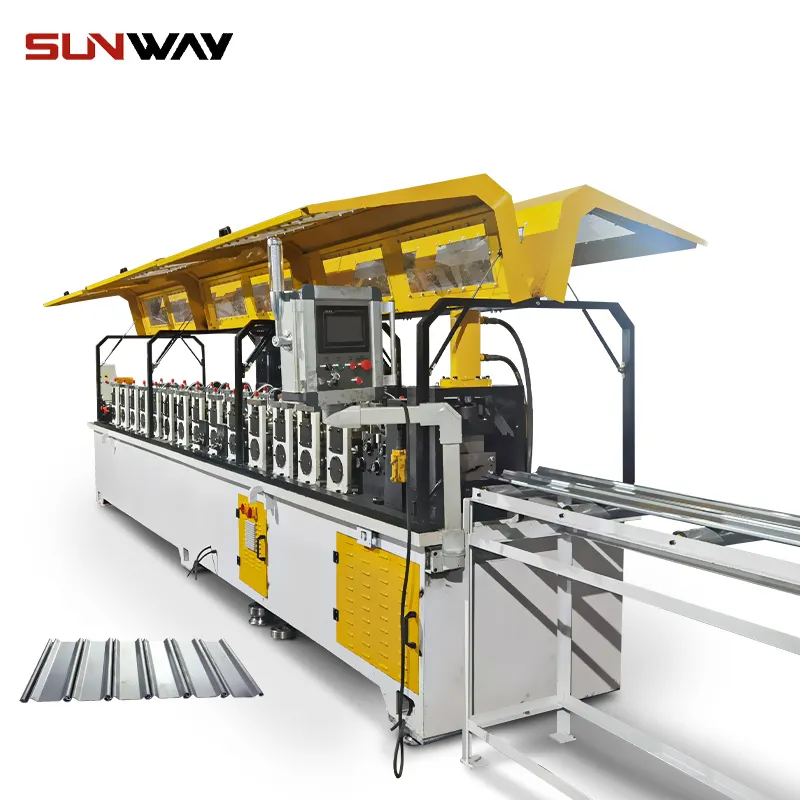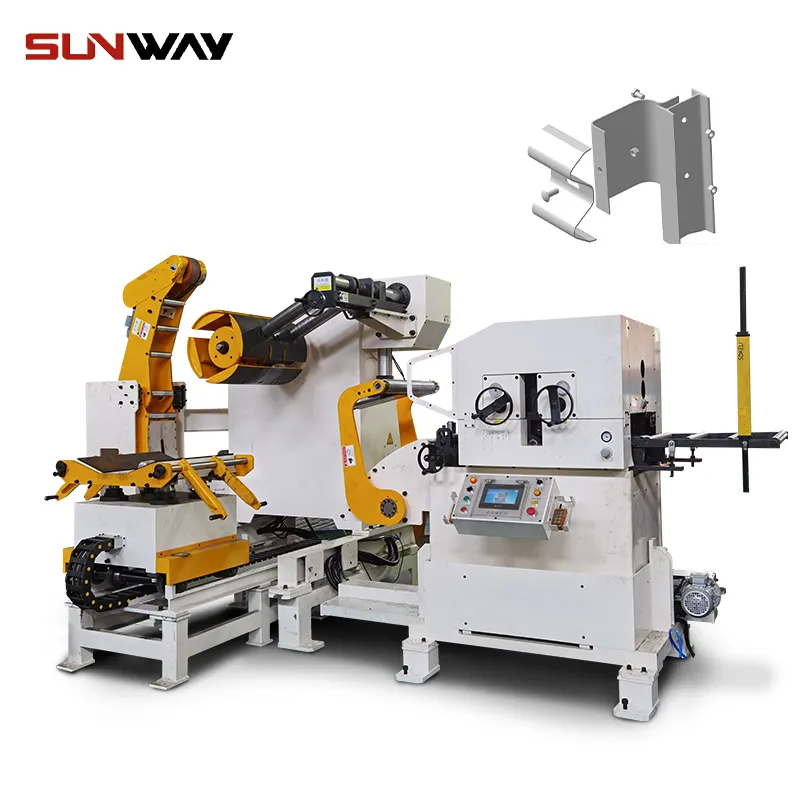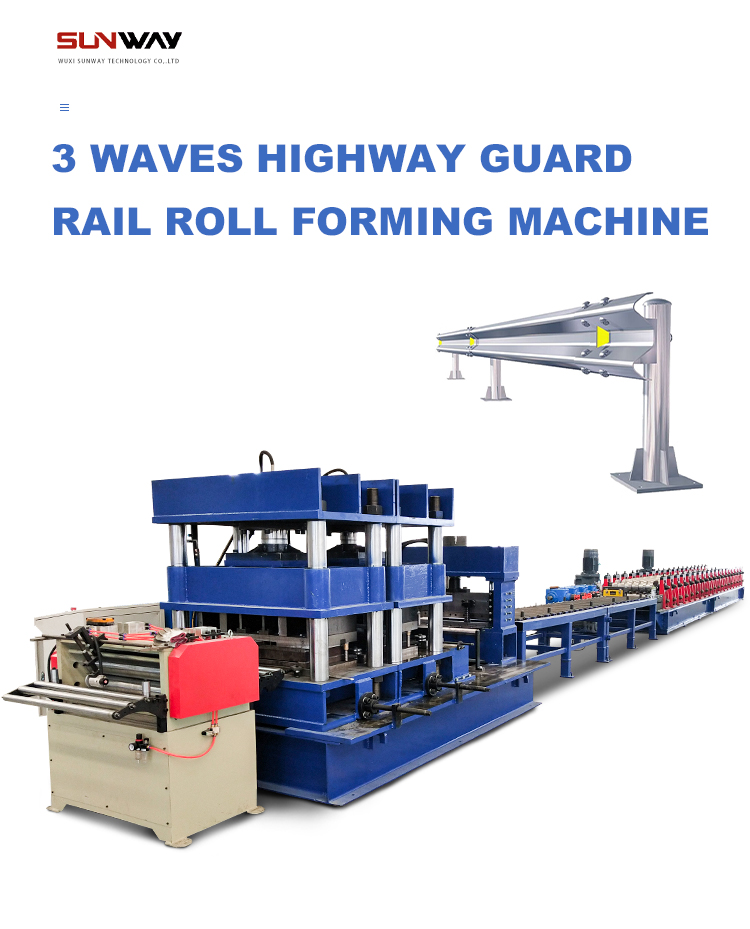Unistrut roll forming machines are used to form U-channel metal studs and joists from coiled steel. These machines are a key piece of equipment in the structural framing industry. This guide provides a comprehensive overview of unistrut roll forming machine types, components, suppliers, applications, operation, and more.
Overview of Unistrut Roll Forming Machines
Unistrut roll forming machines take flat strip steel coil as input and progressively form it into U-channel shapes through a series of rolling and bending operations. The steel profiles produced are used for structural framing in walls, roofs, mezzanines, solar panel mounts, and numerous other applications.
Key details about unistrut roll forming machines:
- Also called C/U channel roll formers or stud and track roll forming machines
- Available in manual, semi-automatic, and fully automatic versions
- Production capacities from 10 to 200 feet/minute
- Form U-channel, C-channel, studs, tracks, furring channels
- Use CAD software for profile design and roll tooling setup
- Roller boxes house bearing blocks with forming rollers
- Rollers are machined to shape to bend and form the steel strip
- Punching units to punch service holes in the profile flanges
- Decoilers hold steel coil inputs up to 5 tons
- Feed tables with edge guides align the strip
- Programmable controls for automatic production
- Range of widths up to 2.5″, thicknesses 22 to 16 gauge
Unistrut Roll Former Types
There are three main types of unistrut roll forming machines:
| Machine Type | Description |
|---|---|
| Manual | Basic machines with manual material feeding and cutoff. Low production rates. |
| Semi-Automatic | Automated feeding and cutting but manual part offloading. Intermediate rates. |
| Fully Automatic | Automated coil loading, feeding, forming, cutting, part stacking. Highest throughput. |
Unistrut Roll Former Components
Unistrut roll forming machines consist of the following main components:
- Decoiler: Holds the steel coil, allows controlled unwinding. Has a payoff reel and coil mandrel.
- Feed table: Supports and guides the strip feeding into the roll forming section. Has edge guides.
- Forming section: Roller boxes with machined rollers make progressive bends to shape the strip.
- Punching unit: Optional station with punch and die for punching service holes.
- Cutoff press: Shears the formed profile to desired lengths. Manual or automated.
- Stacking table: Collects cut parts as they exit the machine. Can have automated stacking.
- Electrical cabinet: Houses the controls, drives, and automation system.

Applications of Unistrut Roll Forming Machines
Unistrut roll forming machines produce standardized and custom U-channel metal framing profiles for the following applications:
- Drywall and curtain wall construction
- Roof trusses, purlins, eave struts
- Electrical trunking and cable trays
- Solar panel mounts
- Mezzanine and storage platforms
- Material handling systems
- Agricultural buildings
- Transmission towers
- Scaffolding
- Greenhouses
- Pallet racking
- Conveyor systems
Common materials rolled include galvanized steel, stainless steel, and aluminum.
Unistrut Roll Former Specifications
Unistrut roll forming machines are available with a range of specifications to suit different production requirements:
| Parameter | Typical Range |
|---|---|
| Width Capacity | 1.5 – 3 inches |
| Thickness Capacity | 0.7 – 2 mm (22 – 16 gauge) |
| Profile Height | 1 – 6 inches |
| Production Speed | 10 – 200 feet/minute |
| Drive Power | 5 – 15 kW |
| Working Precision | ±0.5 mm |
| Coil Weight Capacity | 1 – 5 tons |
| Coil ID | 20 – 32 inches |
How to Choose a Unistrut Roll Forming Machine
Follow these tips for selecting the right unistrut roll former:
- Determine needed profile dimensions and production rate
- Choose between manual, semi-auto, and automatic versions
- Consider coil capacity, line speed, and power requirements
- Select number of forming stands based on profile complexity
- Include decoiler, feed table, cutoff press, and other auxiliaries
- Get punching, notching, drilling units if needed
- Choose reputable manufacturers like Metform, Rollformer, Bradbury
- Look for rugged design, precision machining, high quality components
- Seek machines with fast changeover, easy operation, and maintenance access
- Compare options between suppliers on build quality, features, price
- Check lead time, shipping terms, payment options, and warranty
- Require run samples, factory acceptance testing, and operator training
Careful specification matching will ensure you get a unistrut roll former optimized for your production needs.
Unistrut Roll Forming Machine Manufacturers
There are many competent unistrut roll former manufacturers across the world. Some of the top global suppliers include:
| প্রতিষ্ঠান | Location |
|---|---|
| Metform | United States |
| Rollformer | China |
| Bradbury | United States |
| স্যামকো মেশিনারি | China |
| Metecno | ইতালি |
| Shanghai Metal Corporation | China |
| Jouan Metal | China |
| Ernst Machine Tools | United Kingdom |
| Technoshell Automations | ভারত |
| Ferracci Machines | ইতালি |
When comparing manufacturers, look at production capacity, experience with your product type, quality certifications, customization capabilities, and after-sales service. Visit reference plants to inspect build quality if possible.

Unistrut Roll Former Costs
Unistrut roll forming machine prices depend on the size, production rate, level of automation, and optional features. Typical price ranges:
- Small manual machines: $8,000 – $15,000
- Medium semi-auto roll formers: $20,000 – $60,000
- Large high-speed automated machines: $80,000 – $150,000
Additional costs for decoilers, installation, spare parts, operator training should also be accounted for. Request quotes from several suppliers and compare life cycle costs when making purchase decisions.
How to Install Unistrut Roll Forming Machines
Proper installation of unistrut roll formers improves performance and longevity. Follow these best practices:
- Prepare flat, level, and vibration-free foundation, typically reinforced concrete
- Provide adequate space around machine for operation, maintenance, and material handling
- Use precision instruments to properly level and align machine
- Bolt machine baseplates securely per manufacturer instructions
- Install all safety guards and interlocks before operation
- Electrically ground per local codes and connect power as per manual
- Perform test runs and trial forming to verify correct functioning
- Fine tune processes and make final adjustments based on initial production
How to Operate a Unistrut Roll Former
Here are some tips for safe and optimal unistrut roll former operation:
- Study the operating manual thoroughly before use
- Program the machine settings and download forming profiles
- Ensure all guards are in place prior to powering up
- Feed coil of the specified dimensions into the decoiler
- Thread strip through the roller boxes and align in feed table
- Adjust edge guides and support rollers to center the strip
- Set speed, guide height, and cutoff length per profile
- Initiate automatic operation and monitor forming process
- Inspect first pieces for accuracy before continuous runs
- Periodically measure profile dimensions for quality control
- Stop machine safely if jams, defects, or errors occur and resolve issues
- Maintain steady coil supplies to minimize downtime
- Keep work area clean and clear of obstructions
Unistrut Roll Former Maintenance
Regular maintenance is vital for optimum performance and longevity of unistrut roll formers. Key activities include:
- Clean machine daily using compressed air and vacuum
- Lubricate bearings and sliding parts with oil or grease
- Inspect machine for loose fasteners, leaks, unusual noises
- Verify electrical connections are tight and panels debris-free
- Check rollers, strippers, guides for wear and replace as needed
- Change hydraulic oil and filters per manufacturer schedule
- Inspect drive chains, sprockets, gears for stretch or damage
- Verify pneumatic lines and valves have no leaks or blockages
- Complete partial disassembly for deep cleaning after long runs
- Retighten gibs to eliminate play in guiding components
- Update machine software and test revisions before production
Unistrut Roll Forming Troubleshooting
Some common unistrut roll former issues and solutions:
Problem: Inaccurate profile dimensions
- Check roller adjustment and gap spacing
- Replace worn or damaged forming rollers
- Adjust feed speed or metal thickness
Problem: Strip jamming in machine
- Check for feed misalignment and straighten material
- Clean buildup from forming rollers and stripper plates
- Adjust roller box spacing and stripper pressure
Problem: Excessive strip curling
- Increase edge guide pressure to flatten strip
- Check if forming steps are evenly staggered
- Try slower feed speed and ensure proper lubrication
Problem: Burrs or scratches on formed profile
- Replace worn forming rollers and strippers
- Increase inter-roller spacing slightly
- Polish roller surfaces if needed

FAQs
Q: What thickness of steel coil can be formed on unistrut roll formers?
A: Typical thickness capacity is 22 gauge (0.7mm) to 16 gauge (1.6mm) steel. Maximum capacities around 14 gauge (2mm) are possible on some heavy duty machines.
Q: What length of profile can be produced on unistrut roll forming machines?
A: Standard lengths range from 8 to 24 feet. Custom or automated cutoff presses can produce parts from just a few inches long to over 30 feet.
Q: How fast is the production rate of unistrut roll forming machines?
A: Production speed varies by machine size but is typically 10 to 200 linear feet per minute. Larger automated machines with faster line speeds maximize throughput.
Q: What are the power requirements for unistrut roll forming machines?
A: Most unistrut roll formers require 3-15 kW of power depending on the motor sizes and number of driven sections. Voltages of 220V, 380V, or 480V at 50 or 60 Hz are usually required.
Q: What safety measures should be used with unistrut roll forming machines?
A: Safety measures like guarding, emergency stops, light curtains, lockout/tagout devices, and strict operating procedures should be implemented to protect operators.
Q: What factors affect the price of unistrut roll forming machines?
A: Key pricing factors are production speed, automation level, size and thickness capacity, number of forming heads, brand reputation, and optional features.
Q: Should unistrut roll forming machines be installed on reinforced concrete?
A: Yes, a reinforced concrete slab is recommended to provide a stable foundation immune to vibration and twisting forces during operation.
Q: How often should unistrut roll forming machine maintenance be performed?
A: Daily cleaning and weekly inspections are advised. Full maintenance including oil changes, part replacement, and overhauls should be done every 6-12 months.
Q: What is the typical useful life of a unistrut roll forming machine?
A: With proper installation, operation, and maintenance, quality unistrut roll formers will last 15-25 years in full time production conditions.
Frequently Asked Questions (FAQ)
1) What differentiates a Unistrut roll forming machine from a generic C-channel roll former?
- Unistrut channels require precise inward return lips and perforation patterns to accept spring nuts and accessories. Machines are tooled for tighter flange radii, higher dimensional repeatability (±0.3–0.5 mm), and often integrate servo punching for slot/oblong patterns compliant with NEMA and seismic bracing specs.
2) How do I size the number of forming stations for Unistrut profiles?
- As a rule of thumb, stations ≈ (total bend angle in degrees ÷ 15) + 4 to 6 for calibration and lips. Typical 41×41 mm slotted channel in 2.0 mm steel uses 16–22 stations depending on yield strength, radii, and surface finish requirements.
3) Can one line produce multiple Unistrut channel sizes?
- Yes, with cassette-type tooling, quick-change spacers, and motorized width adjustment. Look for recipe-driven setups and datum-based tooling to cut changeover to 10–20 minutes between 41×21, 41×41, and back-to-back profiles.
4) What punching options are best for slotted Unistrut channels?
- Servo CNC punching or rotary punching heads. Servo systems allow flexible pitch (e.g., 18×28 mm slots at 50 mm pitch) with ±0.2 mm positional accuracy and barcode-driven job change. Rotary heads are faster for fixed patterns but less flexible.
5) How does steel grade affect machine choice and tooling life?
- Higher-strength steels (e.g., S350–S420, ASTM A653 50 ksi) need larger bend radii, more stations, and harder tool steels (D2, SKD11) with TiN/TiCN coatings. Verify mill certs and run-off samples to confirm springback compensation and burr limits.
2025 Industry Trends
- High-mix, low-volume production: Auto changeover and recipe libraries are standard on premium Unistrut roll forming machines to serve diversified SKUs (solid, slotted, back-to-back).
- Sustainability and compliance: Increased adoption of ZAM (Zn-Al-Mg) coated steel and EPD-backed coils; buyers request CE/UKCA, ISO 9001, and machinery safety PL d rating evidence.
- Data-driven quality: In-line vision systems verify slot presence, burr height, and flange angle; SPC dashboards tie into MES for traceability.
- Energy efficiency: Regenerative servo drives and smart idle reduce kWh/m by 8–15% vs. 2022-era lines.
- Regionalization: Shorter supply chains for construction hardware push OEMs to add flexible punching and quick die changes.
Key 2023–2025 benchmarks for Unistrut Roll Forming Machine buyers
| Metric | 2023 | 2024 | 2025 (est.) | Notes/Sources |
|---|---|---|---|---|
| Typical line speed with servo punching (m/min) | 10–14 | 12–18 | 14–22 | OEM catalogs; factory FAT reports |
| Auto changeover adoption on new lines (%) | 38 | 46 | 55 | Industry buyer surveys |
| Average changeover time (manual vs. auto) (min) | 45–70 / 20–30 | 40–60 / 15–22 | 35–50 / 10–18 | Integrators’ demos |
| Energy use (kWh/100 m, 2.0 mm GI, slotted) | 8.5–9.8 | 7.8–9.0 | 7.2–8.5 | Vendor energy audits |
| Share using ZAM-coated coils for channels (%) | 10 | 14 | 20 | World Steel/coil coater reports |
| In-line QC with vision/laser gauging adoption (%) | 22 | 29 | 37 | Automation suppliers |
| Typical dimensional repeatability (mm) | ±0.6–0.8 | ±0.5–0.6 | ±0.3–0.5 | FAT/SAT data, buyer specs |
Selected references:
- NEMA VE 1 and VE 2: https://www.nema.org/standards
- ISO 14120, ISO 13849-1 (PL d safety): https://www.iso.org
- World Steel Association coatings and sustainability: https://worldsteel.org
- IEC 61439 (assemblies using support channels, bonding): https://webstore.iec.ch
- UL Product iQ (hardware/bonding components): https://productiq.ul.com
Latest Research Cases
Case Study 1: Rapid Changeover Unistrut Line for OEM Diversification (2025)
- Background: A North American framing OEM expanded SKUs to include 41×21, 41×41, and back-to-back channels in 1.5–2.5 mm GI and ZAM for seismic markets.
- Solution: Installed 22-station roll former with cassette tooling, servo CNC punching (±0.2 mm), regenerative drives, and in-line laser angle measurement tied to automatic roll gap correction.
- Results: Changeover reduced from 58 to 16 minutes; scrap down 2.1%; energy intensity cut 11%; first-pass yield reached 98.4%. Sources: OEM SAT report; internal energy dashboard.
Case Study 2: Corrosion-Optimized Unistrut Channels for Coastal Solar (2024)
- Background: EPC contractor faced premature corrosion on hot-dip galvanized channels in C4–C5 environments for PV racking.
- Solution: Transitioned to ZAM-coated S350 steel on existing line; modified flower pattern and added edge-conditioning to minimize microcracks; implemented conductivity checks for bonding continuity.
- Results: 1,000 h NSS per ISO 9227 showed <5% red rust on cut edges; field inspections at 9 months reported zero blistering; installed cost +4% but lifecycle savings 15% via reduced replacements. Sources: Third-party lab report; EPC QA records.
Expert Opinions
- Dr. Hannah Lee, Materials Engineer, World Steel Association
- “Zinc–aluminum–magnesium coatings significantly improve edge protection for roll-formed channels, enabling thinner gauges without sacrificing service life in C4/C5 atmospheres.”
- Marco De Santis, Automation Lead, Bradbury Group
- “Recipe-driven punching paired with auto gap/offset correction is the single highest ROI upgrade on Unistrut roll forming machines—typically a sub-12-month payback in high-mix plants.”
- Priya Natarajan, P.E., Senior Structural Engineer, SECB
- “For seismic bracing, slot tolerances and repeatable flange geometry matter as much as steel grade. Specify verification via witnessed load and pull-through tests to NEMA VE 1.”
Practical Tools/Resources
- NEMA VE 1/VE 2 (standards, installation for support systems): https://www.nema.org/standards
- AISI S100 and Cold-Formed Steel Design Manual (profiling and design): https://www.awc.org/standards/aisi
- World Steel Association corrosion/coating resources: https://worldsteel.org
- ISO 13849-1 (functional safety for machinery): https://www.iso.org/standard/69883.html
- UL Product iQ (bonding/grounding listings for channel hardware): https://productiq.ul.com
- RSMeans (cost benchmarking for fabrication/installation): https://www.rsmeans.com
- FreeCAD and OpenCascade for roll flower development/CAD: https://www.freecad.org
- Keyence/SICK application notes for in-line vision and laser gauging: https://www.keyence.com
Procurement checklist for a Unistrut Roll Forming Machine
- Define channel family: sizes (41×21, 41×41, back-to-back), slot patterns, hole pitches, and tolerances.
- Verify thickness and grade range (e.g., 1.5–2.5 mm; S250–S420; GI/ZAM/SS/Al) with run samples.
- Specify punching method (servo vs. rotary), positional accuracy, burr limit (<0.05 mm), and deburr if required.
- Require auto changeover (cassette tooling, motorized width) with documented time targets.
- Demand safety compliance (CE/UKCA, ISO 12100, ISO 13849-1), FAT/SAT protocols, and spare parts kit.
- Integrate QC: in-line angle measurement, slot presence detection, SPC export to MES/ERP.
- Include energy metering and OEE tracking for continuous improvement.
Maintenance quick wins
- Daily: clean swarf, inspect punches/dies for wear, check lube levels.
- Weekly: verify roll alignment and gap, calibrate vision/laser sensors.
- Quarterly: inspect drive chains/gearboxes, update PLC/HMI backups, review SPC for drift and adjust flower pattern as needed.
Last updated: 2025-10-28
Changelog: Added 5 FAQs; inserted 2025 trends with benchmarking table and sources; included two recent case studies; added expert opinions; curated tools/resources plus procurement and maintenance checklists for Unistrut roll forming machines
Next review date & triggers: 2026-05-31 or earlier if NEMA/ISO/IEC standards change, ZAM supply/pricing shifts >10%, or automation features (auto changeover, in-line QC) adoption changes significantly
